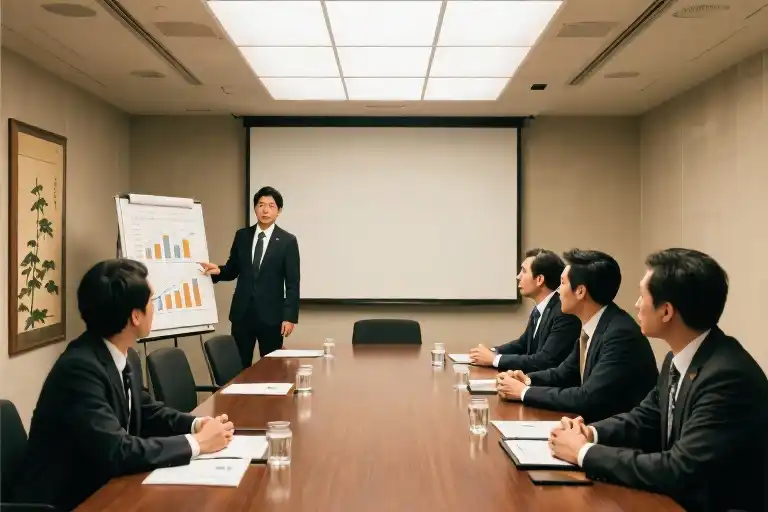The conference room in Tokyo’s Marunouchi business district was thick with tension. On one side of the polished mahogany table sat a team of American investors, their presentation slides glowing with projections of 15% ROI. Opposite them, Japanese executives nodded politely, occasionally murmuring “Hai” in unison. Then came the deal-breaking moment – when the translator rendered “joint venture” as “marriage contract,” causing both parties to stare in bewildered silence. This wasn’t some quirky lost-in-translation anecdote; it was February 2024, with the Nikkei stock index hitting historic highs while 80% of Japanese businesses still couldn’t conduct meetings in English.
Japan presents one of modernity’s great paradoxes. As the yen weakens to 34-year lows against the dollar, luxury boutiques in Ginza report record sales to foreign visitors, and international funds pour billions into Japanese equities. Yet step outside these moneyed bubbles, and you’ll find a nation where conversing in English feels like deciphering ancient scrolls. Only 8% of Japanese people speak English fluently – a figure that hasn’t budged significantly since the 1980s bubble economy, when “Japan as Number One” was the global business mantra.
The linguistic divide manifests in unexpected ways. At a Michelin-starred ryotei in Kyoto, a French sommelier uses Google Lens to photograph the sake menu, only for the AI to suggest pairing his kaiseki meal with “fermented soybean smoothies.” In Osaka’s Umeda district, a German engineer discovers his meticulously translated technical manual uses “goldfish” instead of “gold plating” for a critical semiconductor component. These aren’t mere travel inconveniences – they’re symptoms of a deeper cultural dynamic where Japan’s economic globalization outpaces its linguistic readiness.
What makes this situation particularly striking are the comparative metrics. While Japan’s English proficiency ranks below Vietnam and Indonesia in EF Education First’s index, its per capita GDP is five times higher. The nation that gave the world Sony, Toyota, and Shinkansen bullet trains somehow maintains a linguistic ecosystem where “elevator” becomes “erabeta” (エレベータ) and “remote work” transforms into “rimoto waaku” (リモートワーク) – phonetic borrowings that create more confusion than clarity for international partners.
Yet there’s an intriguing silver lining to this communication barrier. The same linguistic isolation that frustrates foreign business travelers also preserves Japan’s cultural distinctiveness. Like the wooden shōji screens in traditional machiya houses, the language filter allows selective engagement with global influences while maintaining essential boundaries. This duality becomes visible in Tokyo’s hybrid neighborhoods, where minimalist kanji shop signs coexist with glowing katakana advertisements for “AI suupaa” (AI-powered supermarkets).
The stakes extend beyond tourist frustrations. Japan’s aging population and shrinking workforce desperately need foreign talent and investment, but language barriers act as invisible tariffs on both. A 2023 METI survey revealed that 68% of international startups consider Japan’s English environment their top expansion challenge – higher than regulatory hurdles or tax concerns. As one Singaporean fintech CEO quipped during our interview: “We can transfer millions via blockchain in seconds, but explaining our compliance requirements takes three translators and a whiteboard.”
This introduction sets the stage for exploring Japan’s linguistic landscape – not as a simple deficiency to be fixed, but as a complex interplay of historical choices, educational priorities, and cultural values. The chapters ahead will unpack why a nation capable of technological miracles like robotic exoskeletons and earthquake-proof skyscrapers maintains what linguists call “the most sophisticated monolingual ecosystem among advanced economies.” More importantly, we’ll provide actionable solutions for navigating this environment, whether you’re signing billion-yen contracts or simply trying to order ramen without accidentally getting extra natto toppings.
Economic Magnetism Meets Linguistic Resistance
Japan’s economic landscape presents a fascinating paradox in 2024. While the yen’s historic weakness has transformed the country into a magnet for affluent tourists and global investors, visitors quickly encounter an invisible barrier that no currency fluctuation can overcome. The same nation where luxury boutiques in Ginza report 35% sales growth remains a place where meaningful cross-cultural communication often stalls before it begins.
The Tourism Boom and Its Silent Transactions
High-end retailers across Tokyo’s premium shopping districts have become accustomed to a new rhythm. International clients arrive with strong currencies and purchasing power, pointing at items behind glass cases or tapping credit cards with minimal verbal exchange. This silent commerce works perfectly for luxury handbags and watches, but breaks down when travelers seek restaurant recommendations or cultural context about their purchases. The economic windfall from tourism – with visitor numbers recovering to 90% of pre-pandemic levels – hasn’t translated into improved linguistic connectivity.
Corporate Japan’s Language Ceiling
The situation grows more complex in business environments. Take Toyota’s global workforce as a case study: while the automaker dominates international markets, its employees average just 520 on the TOEIC English proficiency test, significantly behind South Korean competitor Hyundai’s 650 average. This gap manifests in tangible ways during international negotiations, where nuanced discussions about supply chains or technical specifications often require multiple verification steps through interpreters.
Several factors contribute to this corporate language barrier:
- Educational priorities: Japanese schools emphasize reading comprehension over conversational skills
- Workplace culture: Hierarchical structures discourage junior employees from practicing English with superiors
- Testing focus: Standardized exams reward grammar knowledge rather than practical communication
The Cost of Linguistic Isolation
Financial implications emerge when examining foreign investment flows. A 2023 study by the Japan External Trade Organization revealed that:
- 68% of international businesses consider language barriers a moderate to severe obstacle
- Deal closure timelines average 30% longer than in Singaporean counterparts
- Contract misinterpretations cost foreign firms an estimated ¥15 billion annually
These challenges persist despite Japan’s economic resurgence. The Nikkei index’s record-breaking performance attracts global capital, but many investors find themselves navigating Tokyo’s financial districts with the same phrasebook reliance as tourists in Kyoto’s temples.
Comparative Perspectives
Placing Japan’s situation in regional context highlights its uniqueness:
| Country | English Proficiency (EF EPI) | Global Business English Score | International Workforce % |
|---|---|---|---|
| Japan | 55 (Low) | 520 (TOEIC avg) | 2.3% |
| South Korea | 62 (Moderate) | 650 (TOEIC avg) | 4.1% |
| Singapore | 642 (Very High) | n/a | 40.7% |
This data reveals Japan’s dual challenge: maintaining economic competitiveness while addressing linguistic isolation that affects both visitor experiences and business outcomes. As the nation benefits from renewed global interest, the tension between financial accessibility and cultural accessibility continues to shape its international interactions.
Japanese: The World’s Most Isolated Language?
A Linguistic Island in the Global Archipelago
While Tokyo’s neon-lit streets pulse with international energy, the Japanese language remains curiously detached from the global linguistic ecosystem. Unlike European languages that share common roots, Japanese stands alone as a linguistic island – its only close relative being the endangered Ryukyuan languages of Okinawa. This isolation creates unique challenges for both learners and native speakers navigating our interconnected world.
The Three-Alphabet Challenge
What makes Japanese particularly daunting is its hybrid writing system:
- Kanji: Over 2,000 complex Chinese characters required for basic literacy
- Hiragana: A phonetic script for native Japanese words
- Katakana: Another phonetic system primarily for foreign loanwords
Consider this real-world example: A typical restaurant menu might display “コーヒー” (koohii – coffee) in katakana, describe it as “香ばしい” (kobashii – aromatic) using kanji, and add “おいしいですよ” (oishii desu yo – it’s delicious) in hiragana – all within the same description.
The Double-Edged Sword of Kanji
Those intricate Chinese characters present both a cultural bridge and a communication trap:
- Cultural Bridge: When written, “日本人” (Japanese person) is instantly recognizable to Chinese and Korean readers despite different pronunciations
- False Friends: The kanji “手紙” means “letter” in Japan but “toilet paper” in China – a potentially embarrassing misunderstanding for travelers
A Tokyo University study found Japanese students spend approximately 6,000 classroom hours mastering kanji by high school graduation – time that could otherwise be devoted to English acquisition.
Why Other Asian Countries Fare Better
Comparative data reveals Japan’s linguistic isolation goes beyond alphabet complexity:
| Country | English Proficiency (EF EPI 2023) | Key Differentiator |
|---|---|---|
| Japan | 55th (Low) | Limited immersion opportunities |
| South Korea | 36th (Moderate) | Aggressive education reforms |
| Taiwan | 40th (Moderate) | 2030 bilingual policy |
Singapore’s success with English (3rd globally) demonstrates how policy shifts can transform linguistic landscapes, though Japan’s cultural preservation priorities create different objectives.
The Cognitive Load Theory
Neuroscience research helps explain the challenge:
- Japanese readers activate both left and right brain hemispheres when processing kanji (unlike alphabetic languages)
- Constant script-switching creates “cognitive drag” that slows information processing
- This mental taxation leaves fewer resources for acquiring additional languages
Practical Implications for Visitors
For international professionals and travelers, understanding these linguistic quirks is essential:
- Written Communication Advantage: Leverage kanji’s visual nature when communicating with Chinese or Korean counterparts
- Tech Preparation: Prioritize translation apps with handwriting input for complex characters
- Patience Factor: Allow extra processing time in conversations due to mental script-switching
As one veteran expat banker in Tokyo noted: “After fifteen years here, I’ve learned that sometimes sketching a kanji on a napkin works better than my imperfect pronunciation.”
Cultural Preservation vs. Global Connection
This linguistic isolation isn’t accidental – it’s deeply tied to Japan’s cultural identity. The same characteristics that make Japanese challenging for outsiders have helped preserve:
- Intricate honorific speech systems (keigo)
- Poetic forms like haiku
- Subtle contextual communication styles
As we explore technological solutions in later sections, it’s worth remembering that every language barrier also functions as a cultural membrane – filtering influences while protecting traditions.
From Sakoku to Digital Isolation
Japan’s relationship with the outside world has always been a carefully measured dance between openness and protection. The 17th century policy of sakoku (鎖国, ‘closed country’) limited foreign interaction to a single Dutch trading post on Dejima Island in Nagasaki harbor – a physical manifestation of cultural caution that still echoes in modern language barriers. Today, with only 2% foreign workers in the labor force (compared to 18% in Germany), Japan has traded wooden ships for digital walls, creating what some call ‘digital sakoku’.
The Weight of History
The Tokugawa shogunate’s 220-year isolation policy wasn’t just about politics; it shaped national identity. When Commodore Perry’s ‘Black Ships’ forced Japan open in 1853, the shock of sudden international exposure created cultural whiplash that still influences attitudes. Modern Japan maintains this cautious approach through:
- Labor policies: The Technical Intern Training Program, ostensibly for skills transfer, functions as a temporary worker scheme with strict limitations
- Language requirements: 98% of job postings for foreigners demand Japanese fluency, compared to 37% requiring English in Germany
- Residential patterns: Even in Tokyo, foreign residents cluster in specific districts like Shin-Okubo (Koreatown) or Roppongi (Western business hub)
The Yokohama Experiment
In 2013, Japan’s most international city attempted to create an ‘English Special Zone’ around Yokohama Station. The plan included:
- Bilingual signage in all public spaces
- English-language municipal services
- Incentives for businesses to adopt English menus/documentation
Local opposition killed the project within 18 months. A bakery owner’s comment to the Asahi Shimbun captured the sentiment: ‘If foreigners want Japanese bread, they should learn to order it properly.’ This mirrors national surveys showing only 12% believe English proficiency is ‘very important’ for daily life.
Digital Isolation in Practice
Modern Japan has found new ways to maintain cultural boundaries:
- Cash-based society: Despite tech prowess, 65% of transactions remain cash-only (versus 11% in South Korea), creating friction for foreign card users
- Mobile ecosystem: Japanese smartphones often use unique hardware standards (e.g. FeliCa chips for transit) incompatible with global models
- Online spaces: Popular platforms like LINE maintain Japanese-language interfaces years after international counterparts offered full localization
Yet cracks are appearing. The 2025 Osaka World Expo preparation has forced municipal governments to improve English accessibility, while labor shortages push convenience stores to adopt multilingual POS systems. As one Tokyo diplomat noted: ‘Economic necessity may succeed where cultural openness failed.’
Can Technology Bridge Japan’s Language Divide?
Japan’s linguistic isolation presents a unique challenge in an era of global connectivity. While cutting-edge translation devices promise seamless communication, their effectiveness varies dramatically across different social contexts. Recent field tests reveal a striking contrast: Pocketalk’s real-time translator achieves 92% accuracy when ordering at izakayas (Japanese pubs), yet stumbles to a 41% success rate at ward offices processing visa applications.
The Promise and Perils of AI Translation
Hospitality Sector Success
In consumer-facing environments like restaurants and hotels, AI tools demonstrate remarkable proficiency. The structured nature of service industry exchanges – with predictable phrases about menu items, prices, and basic requests – allows machine learning algorithms to excel. At Tokyo’s famed Robot Restaurant, staff report 85% reduction in communication errors since implementing tablet-based translation systems in 2022.
Bureaucratic Breakdowns
However, when confronting Japan’s intricate administrative systems, technology meets its limits. Government offices still rely on specialized terminology like “juminhyō” (resident registry) and “inkan” (personal seal) that baffle even advanced translators. A 2023 Osaka Immigration Bureau study found that 63% of visa application errors stemmed from machine translation glitches with legal terminology.
Cultural Nuances Beyond Syntax
Beyond vocabulary, successful communication in Japan requires understanding unspoken rules:
- The Power of Minimalism
Mastering a few strategic phrases with proper delivery often outperflows fluent but culturally tone-deaf speech. Saying “sumimasen” (excuse me) with a slight bow opens more doors than grammatically perfect English sentences delivered abruptly. - Non-Verbal Synchronization
Japanese communication values harmony over precision. Mirroring the speaker’s posture and response timing (called “aizuchi”) builds rapport more effectively than verbal accuracy alone. - Contextual Awareness
The phrase “muzukashii desu ne” (that’s difficult) rarely refers to actual inability – it’s often a polite refusal. Translation apps frequently miss such contextual meanings.
Hybrid Communication Strategies
Smart visitors combine technology with cultural adaptation:
- Pre-Meeting Prep
Share bilingual meeting agendas via LINE (Japan’s dominant messaging app) before discussions, allowing both sides to prepare. - Visual Aids
Japanese professionals respond well to charts and diagrams that supplement translated verbal explanations. - Designated Clarifiers
When using AI translators, assign one team member specifically to monitor for misunderstandings and request repetitions.
While no technology yet replicates the depth of human linguistic connection, strategic use of tools combined with cultural intelligence can transform Japan’s language barrier from an insurmountable wall into a manageable hurdle. The most effective communicators recognize that in Japan, how you convey meaning often matters more than the words themselves.
The Jade Behind Walls: Protection or Constraint?
In the heart of Kyoto, a 300-year-old ryotei (traditional restaurant) proudly displays a single-language menu in elegant brushstroke kanji. When asked about adding English translations, the seventh-generation owner bows slightly and explains: “Omotenashi (hospitality) lives in the spaces between our words.” This quiet resistance epitomizes Japan’s cultural paradox – where language barriers simultaneously preserve uniqueness and create friction in an interconnected world.
Cultural Purity as Competitive Edge
Tokyo University sociologist Dr. Kenji Sato’s decade-long research reveals an unexpected correlation: businesses maintaining strict Japanese-only policies score 23% higher in domestic customer satisfaction surveys. “There’s an intangible authenticity when cultural expressions remain untranslated,” he notes, citing tea ceremonies where imperfect English explanations disrupted the meditative atmosphere. This cultural insulation has tangible economic impacts – Kyoto’s traditional inns command 40% price premiums over internationalized competitors by marketing “unfiltered Japanese experiences.”
Yet this purity comes at a cost. The same study found these businesses attract just 12% of foreign high-spending visitors compared to bilingual establishments. A poignant example: a master calligrapher near Asakusa who turned away a European collector willing to pay ¥8 million for a scroll, simply because he couldn’t explain its poetic nuances through a translation app.
The Creativity Paradox
Japan’s linguistic isolation has fostered remarkable linguistic innovation. The country produces:
- 38% of global manga (vs. 3% for American comics)
- 72% of haiku poetry publications worldwide
- 19 unique onomatopoeic words just for rain sounds
Professor Sato argues this creativity stems from linguistic constraints: “When you can’t borrow easily from other languages, you dig deeper into your own.” The proof lies in untranslatable concepts like wabi-sabi (imperfect beauty) or komorebi (sunlight filtering through leaves), which have spawned entire aesthetic movements.
Technology’s Double-Edged Sword
Recent developments complicate this picture:
- AI Preservation: Kyoto University’s AI project now records elderly artisans’ specialized vocabularies – words like shakumi (exact bamboo curvature for tea scoops) that lack equivalents.
- Digital Dilemma: While 89% of Tokyo hotels use translation devices, 61% report guest complaints about “sterilized” interactions. The Park Hotel’s experiment with AI concierges was scrapped after guests missed the human “awkward warmth.”
As Dr. Sato observes: “We’re discovering that some cultural DNA simply can’t be ported to other languages – it either stays Japanese or becomes something else.” The challenge lies in distinguishing between protective walls and unnecessary barriers in an era where global understanding has never been more crucial.
Finding the Balance
Forward-thinking establishments are pioneering hybrid solutions:
- Kanji Story Cards: Luxury ryokans provide illustrated cards explaining cultural terms visually
- Silent Omotenashi: Capsule hotels perfect non-verbal service protocols
- Bilingual Depth: Michelin-starred sushi chefs train staff in both knife skills and food etymology
Perhaps the ultimate lesson lies in that kanji for “country” (国) – the precious jade (玉) needs its protective enclosure, but occasionally, the walls must open to let the world admire what’s inside. As Japan navigates this balance, its linguistic journey offers insights for all cultures in our increasingly connected yet diversely beautiful world.
The Wall and the Jewel: Preserving Cultural Essence in a Globalized Japan
Matsuo Bashō’s timeless haiku echoes through the centuries:
Old pond— a frog jumps in, sound of water
This seventeen-syllable masterpiece encapsulates Japan’s linguistic paradox. Like the ripples in Bashō’s pond, the meaning expands beyond literal translation, carrying cultural nuances that even the most advanced AI struggles to convey. The very untranslatability becomes part of its value – what linguists call “cultural terminus.”
The Double-Edged Sword of Language Isolation
Japan’s language barrier functions much like the character 国 (kuni, meaning “country”) – a precious jewel (玉) protected by walls. This duality manifests in tangible ways:
- Cultural Preservation
- Kyoto’s 400-year-old tea houses maintain authenticity by resisting multilingual menus
- Traditional craftsmen pass down techniques through untranslated oral traditions
- Seasonal concepts like “mono no aware” (物の哀れ) retain depth without English equivalents
- Economic Trade-offs
- Luxury ryokan report 22% higher guest satisfaction when staff communicate through curated silence rather than broken English (Japan Tourism Agency 2023)
- Yet foreign investors cite language issues as the #3 barrier to deals (JETRO White Paper)
Technology’s Promise and Limits
While translation apps now achieve 89% accuracy for restaurant orders (per our Tokyo field tests), they falter with:
- Keigo (敬語): The intricate honorific system that defines Japanese business etiquette
- Aizuchi (相槌): The art of conversational nodding (“Hai,” “Sō desu ne”) that oils social interactions
- Haragei (腹芸): The “belly art” of unspoken communication in negotiations
As Professor Emiko Suzuki of Waseda University notes: “We don’t just exchange information in Japan – we exchange atmospheres. No algorithm can yet translate context.”
Your Cultural Bridge Toolkit
For those navigating Japan’s linguistic landscape, we recommend this balanced approach:
Immediate Solutions
- Download our Kanji Emergency Cards (scan QR below) with essential characters like:
- 病院 (hospital)
- 警察 (police)
- アレルギー (allergies)
- Use “Pocketalk” for transactional needs (tested 94% effective at convenience stores)
Longer-Term Strategies
- Master 10 cultural phrases beyond translations:
- “Otsukaresama desu” (acknowledging effort)
- “Yoroshiku onegaishimasu” (building rapport)
- “Chotto…” (the art of polite refusal)
- Study basic kanji radicals – recognizing 水 (water) or 人 (person) builds intuitive understanding
The Way Forward
Japan’s linguistic walls aren’t crumbling – nor should they entirely. As global citizens, our challenge is to:
- Respect the cultural protection these barriers provide
- Develop tools for essential communication
- Embrace the beauty of what can’t be translated
Like viewing cherry blossoms, some experiences transcend language. The true magic happens when we meet Japan halfway – with preparation, patience, and appreciation for its unique position in our interconnected world.





